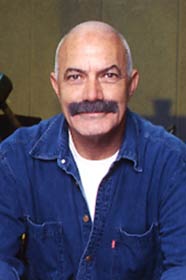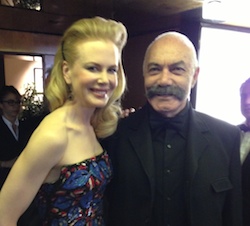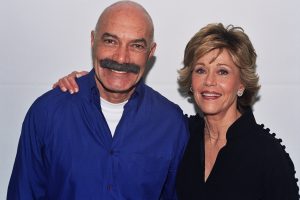The special edition of Sweeney Todd (April 1) comes as “Costco,” The Sweeney Todd Fleet Street Gift Set, which includes the 2 Disc Special Edition DVD and the lavish, hardcover official companion book with a forward by Tim Burton. This exclusive book includes over 200 photos, concept drawings and production designs, extracts from the screenplay and interviews with the cast including Johnny Depp and Helena Bonham Carter.
Other features: “Best Buy”–Free movie ticket to the much anticipated horror film The Ruins when you purchase the Sweeney Todd DVD. “Borders,” a Sweeney Todd DVD including the abridged version of the official Sweeney Todd Companion book which includes behind the scenes shots from the film and more. “Suncoast & FYE,” a limited edition swank steel book packaging.
Film Review
Dark, haunting, and unified in theme and style, “Sweeney Todd: The Demon Barber of Fleet Street,” Tim Burton’s horror-musical movie of Stephen Sondheim’s masterpiece, is a brilliant work of art. Coherent and uncompromising, this smooth rendition should satisfy the purists and fans of the 1979 Tony award-winning Broadway show-despite a number of narrative and musical changes, some of which for the better (see below).
DreamWorks/Warner, justifiably confident about their eccentric fare, have decided to open the musical wide, on December 21, as a big Christmas event movie, instead of platforming it, as was the original design.
As far as movie musicals are concerned, “Sweeney Todd” is superior to last year’s “Dreamgirls” and to this year’s “Hairspray”–it’s the most impressive Hollywood musical to be seen since Baz Luhrmann’s “Moulin Rouge” in 2001, also a visionary work; before that, you may have to go to Bob Fosse’s “Cabaret,” in 1972.
“Sweeney Todd” achieves a number of records. First, it’s the most satisfying film of any Sondheim work transferred to the big screen, including the joyous but artistically mediocre “A Funny Thing Happened on the Way to the Forum,” and the vastly disappointing “A Little Night Music,” a movie that with the exception of one or two actors was miscast. Unfortunately, both movies failed to convey the magic of their respective theatrical productions.
Though nominally it is Burton’s first foray into the musical genre, “Sweeney Todd” is arguably the auteur’s best film in over a decade, since the stylized black-and-white, loving biopic-tribute, “Ed Wood,” in 1994, starring Johnny Depp as the notoriously inept director.
Marking star Johnny Depp’s sixth collaboration with director Tim Burton, following “Edward Scissorhands,” “Ed Wood,” “Sleepy Hollow,” “Charlie and the Chocolate Factory,” and “Corpse Bride,” “Sweeney Todd” is arguably their most fulfilling teaming, one that enables both actor and helmer to stretch and show new facets of their already impressive artistic palette.
Not surprisingly, composer Sondheim, who had a say over three issues, the hiring of the director and the casting of the two leads, Sweeney Todd and Mrs. Lovett, has given his blessing to this endeavor, stepping aside (so to speak), while endowing screenwriter John Logan (“Gladiator”) and director Burton enough artistic liberty to turn his creation into a full-fledged movie that works well on any number of levels.
The most amazing thing about “Sweeney Todd” is that it bears the unique signature of Burton as a filmmaker, while also maintaining the integrity of the work as a quintessential Sondheim work. Indeed, thematically, there’s congruency between the musical’s subject, characters, and mood and Burton’s idiosyncratic sensibility, which has always been at its strongest and most dazzling when dealing with “taboo” issues and misfit persona, the best of which were epitomized by Depp, the most eccentric and iconic actor of his generation.
After watching this “Sweeney Todd,” it’s hard to imagine anyone but Depp in the role of the vengeful barber, driven by anger and sorrow, cruelty and violence. Depp stars in the title role (played by Len Cariou in New York), as a man unjustly sent to prison, who vows revenge, not only for that cruel punishment, but also for the devastating consequences of what had happened to his wife and daughter.
When Sweeney returns to London to reopen his barbershop, he becomes the Demon Barber of Fleet Street, a fictional character that hails back to 1846, when it first appeared in a story, which was later turned into several popular books and plays. John Logan’s screenplay is based on Christopher Bond’s 1973 play, which served as inspiration for Sondheim’s 1979 Broadway musical.
Joining Johnny Depp is Helena Bonham Carter as Mrs. Lovett, Sweeney Todd’s amorous accomplice, who creates her own brand of diabolical meat pies. Neither Depp nor Bonham Carter, who recreates Angela Lansbury’s memorable Broadway role, is a professional singer. However, this is not a problem: Sondheim and Burton have said that their strategy for the movie was to select “actors who could deliver a song,” rather than “singers who could act.”
The saga begins in a typically Burtonian dark and surreal mood, when a ship arrives in London, bringing back Benjamin Barker (Depp), after escaping from 15 years of false imprisonment in Australia. Driven by the single motivation of revenge, Barker vows to kill the evil Judge Thurpin (Alan Rickman, well-cast) and his nefarious henchman Beadle Bamford (Timothy Spall), who had shipped him off to the other side of the world on a trumped-up charge in order to steal from him his wife Lucy (Laura Michelle Kelly) and his baby daughter.
Through snippets of flashbacks, we get a view of better times, when Barker, surrounded by his newly-formed family, was a different kind of man, happier and upbeat. Back at present, Barker adopts the guise of Sweeney Todd, setting up shop in his old Barber Shop, above the pie-making premises of Mrs. Nellie Lovett (Bonham Carter). It’s Mrs. Lovett who informs Sweeney that his wife poisoned herself after Judge Thurpin had taken advantage of her.
When a rival barber, the flamboyant Italian Pirelli (Sacha Baron Cohen) threatens to expose Sweeney Todd’s real identity, Todd kills him, slashing his throat in a mode similar to the slashing in David Cronenberg’s “Eastern Promises,” which is also set in London and in barber shops!
Initially bewildered, not knowing what to do with the bodyPirelli’s finger sticks out of the coffin–Mrs. Lovett proves ultra-resourceful, when she sees the crisis as a potential “solution” to her ailing business, offering to use human flesh as the filling for her pies.
Soon, Todd discovers that the Judge has turned his affections towards Joanna (Jayne Wisener), Sweeney’s now-teenaged daughter, who has become Turpin’s ward. Imprisoned in his house, the abused Joanna is noticed by Anthony (Jamie Campbell Bower), a young, handsome sailor, who had once rescued Sweeney from the sea. Falling hopelessly in love, Anthony vows to rescue Joanna from Turpin’s clutches and marry her himself.
The secondary characters-and their subplots-were never dramatically compelling, or compelling enough to engage our attention, but they offer respite from the predominant claustrophobic setting (most of the film is set indoors), the gloom-and-doom mood, macabre tone, and escalating blood and gore.
In short order, Mrs. Lovett’s pies become a smash hit, the “talk of London,” as she says. As her business continues to boom, she deludes herself with dreams and fantasies of a more bourgeois and respectable life at the seaside, with her new nuclear family: hubby Sweeney and her young charge Toby (Edward Sanders), Pirelli’s former assistant, who functions as her adopted son. Rendition of “By the Sea” is the only sequence in the entire film, which is done against blue skies, and in pastel colors, with the trio moving from one picnic to another.
I have related the synopsis of “Sweeney Todd” in order to convey the notion that the piece has always been a character and mood rather than plot-driven musical, unlike say, “West Side Story,” which Sondheim wrote when he was 25!, “A Funny Thing Happened on the Way to the Forum,” not to mention other seminal Broadway musicals, past or present, such as “The King and I,” “My Fair Lady,” “Mary Poppins,” “Sound of Music.”
In this, and other respects, “Sweeney Todd” is one of a kind, a coherent work in which every scene, song, and production number contribute to the single, general idea of a terrible revenge, one that spirals out of control and destroys not only the avenging angel but all those around him.
Clearly, for the movie, Logan, Sondheim, and Burton have decided to strip the musical to its bare essentials by focusing on its “simple” yet gripping, gory, and tragic tale of revenge. (In interviews that I was lucky to attend in London last week, Sondheim said that they kept asking themselves, why have the story and legendary myth of Sweeney Todd endured for 150 years).
Rather than being intimidated by the source material–which some historians consider to be one of the greatest scores of the past 50 years-Burton and his artistic team have managed to serve it without relying on the more conventional trend of opening the story up by imposing outdoor scenes or superfluous connections. This “Sweeney” Todd is deliberately and consciously dark, claustrophobic, theatrical, and stylized. And yet it’s also very cinematic, due to the smooth transitions from scene to scene, song to song, score to song and vice versa.
Moreover, as a result of the casting-both Sweeney and Mrs. Lovett are younger characters in the film than they were on stage-the emotional stories, and the unrequited love of the mature characters, come across more effectively in the screen version than on the Broadway stage. The young, more nave love between Anthony and Johanna, and the songs that describe that love, are less prominent in the screen version, though the number “Johanna” is repeated, once as an ensemble song.
Embodying Burton’s vision and holding the musical together is Depp’s bravura turn–as actor and singer. Depp perceives Sweeney Todd as a killer and a victim, a dark yet sensitive figure who has experienced a trauma–grave injustice–in his life. He embraces his favored instruments of death, his cutthroat razors, the shiny implements that are also his tools of trade as a barber. Mrs. Lovett held on to them while he was in Australia, but once back in his hands, they become his lifeline and means of revenge, and he serenades them in the powerful song “My Friends,” as his new family and the only love in his life.
The greatness of Depp’s interpretation is that, though he basically plays a nasty, violent, single-minded character, his Sweeney Todd also emerges as a passionate, even sympathetic hero, which explains why our emotions are conflicted–we root for him to accomplish his vendetta mission and then root for him to fall and crash.
Logan, Sondheim, and Burton have taken the Hitchcockian paradigm of the “Wrong Man,” and have carried it to its logical extreme, without any compromises or efforts to soften or brighten the material. As such, “Sweeney Todd” has one of the most coherent but also downbeat and grim ending to be experienced in a Hollywood musical movie in a long long time.
Sign of the times Artistry of the highest caliber Probably both.
Cast
Sweeney Todd – Johnny Depp
Mrs. Nellie Lovett – Helena Bonham Carter
Judge Turpin – Alan Rickman
Beadle Bamford – Timothy Spall
Adolfo Pirelli – Sacha Baron Cohen
Johanna – Jayne Wisner
Anthony Hope – Jamie Campbell Bower
Toby – Edward Sanders
Beggar Woman – Laura Michelle Kelly
Credits
A DreamWorks-Paramount (in U.S.)/Warner Bros. (international) release and presentation of a Parkes/MacDonald production and a Zanuck Co. production.
Produced by Richard D. Zanuck, Walter Parkes, Laurie MacDonald, John Logan.
Executive producer, Patrick McCormick.
Co-producer, Katterli Frauenfelder.
Directed by Tim Burton.
Screenplay, John Logan, based on the musical Sweeney Todd: The Demon Barber of Fleet Street by Stephen Sondheim and Hugh Wheeler from an adaptation of Sweeney Todd by Christopher Bond.
Camera: Dariusz Wolski.
Editor: Chris Lebenzon.
Music and songs: Sondheim.
Production designer: Dante Ferretti.
Supervising art director: Gary Freeman.
Set decorator: Francesca Lo Schiavo.
Costume designer: Colleen Atwood.
Sound: Tony Dawe.
Supervising sound editor: David Evans.
Re-recording mixers: Tom Johnson, Michael Semanick.
Visual effects supervisor: Chas Jarrett.
MPAA Rating: R.
Running time: 116 Minutes










